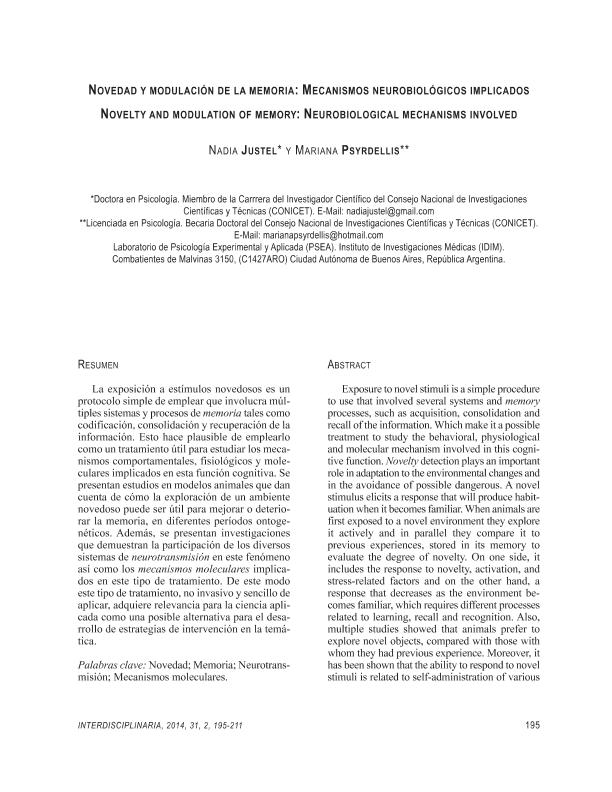Mostrar el registro sencillo del ítem
dc.contributor.author
Justel, Nadia

dc.contributor.author
Psyrdellis, Mariana

dc.date.available
2017-07-14T18:36:30Z
dc.date.issued
2014-12
dc.identifier.citation
Justel, Nadia; Psyrdellis, Mariana; Novedad y modulación de la memoria: Mecanismos neurobiológicos implicados; Consejo Nacional de Investigaciones Científicas y Técnicas. Centro Interamericano de Investigaciones Psicológicas y Ciencias Afines; Consejo Nacional de Investigaciones Científicas y Técnicas. Centro Interdisciplinario de Investigaciones en Psicología Matemática y Experimental; Interdisciplinaria; 31; 2; 12-2014; 195-211
dc.identifier.issn
1668-7027
dc.identifier.uri
http://hdl.handle.net/11336/20662
dc.description.abstract
La exposición a estímulos novedosos es un protocolo simple de emplear que involucra múltiples sistemas y procesos de memoria tales como codificación, consolidación y recuperación de la información. Esto hace plausible de emplearlo como un tratamiento útil para estudiar los mecanismos comportamentales, fisiológicos y moleculares implicados en esta función cognitiva. Se presentan estudios en modelos animales que dan cuenta de cómo la exploración de un ambiente novedoso puede ser útil para mejorar o deteriorar la memoria, en diferentes períodos ontogenéticos. Además, se presentan investigaciones que demuestran la participación de los diversos sistemas de neurotransmisión en este fenómeno así como los mecanismos moleculares implicados en este tipo de tratamiento. De este modo este tipo de tratamiento, no invasivo y sencillo de aplicar, adquiere relevancia para la ciencia aplicada como una posible alternativa para el desarrollo de estrategias de intervención en la temática.
dc.description.abstract
Exposure to novel stimuli is a simple procedure to use that involved several systems and memory processes, such as acquisition, consolidation and recall of the information. Which make it a possible treatment to study the behavioral, physiological and molecular mechanism involved in this cognitive function. Novelty detection plays an important role in adaptation to the environmental changes and in the avoidance of possible dangerous. A novel stimulus elicits a response that will produce habituation when it becomes familiar. When animals are first exposed to a novel environment they explore it actively and in parallel they compare it to previous experiences, stored in its memory to evaluate the degree of novelty. On one side, it includes the response to novelty, activation, and stress-related factors and on the other hand, a response that decreases as the environment becomes familiar, which requires different processes related to learning, recall and recognition. Also, multiple studies showed that animals prefer to explore novel objects, compared with those with whom they had previous experience. Moreover, it has been shown that the ability to respond to novel stimuli is related to self-administration of various drugs, the discovery of spontaneous tumors, and even life expectancy since it was found that neophobic animals die younger than their counterpart's neophilic. In this work we presented studies that indicated how the exploration of a novel environment could be a useful tool to enhanced or deteriorated memory in different ontogenetic stages. The modulation of memory depends on the different characteristic of the treatment presentation. It was reported that the novelty presented prior to an acquisition of some training task can generate an improvement in memory performance. Although, it was founded that the novelty exploration produce an amnesic effect if it was presented after learning, showing the opposite effect. This have been shown in different paradigms such us consummatory successive negative contrast (cSNC) paradigm and inhibition avoidance, in different phases of the training. It was also important to note that this phenomenon involves different time window parameters, for example it is required that the novelty were presented at least one hour before the learning. Furthermore we mentioned data that shows that exposure to novelty during infancy induces a lasting effect of improved cognition and long-term memory that persists even in adulthood. The study of the effect of novelty in the postnatal period and its subsequent influence on other periods opens the possibility of the creative developing of strategies to improve learning and memory processes throughout the subject's life. Besides, we presented research that exhibited the implication of several neurotransmitter systems in this phenomenon and the molecular mechanisms involved in this treatment. Practically all the principal neurotransmitter systems, such as cholinergic, glutamatergic, adrenergic, among others, are involved. A lot of studies indicate that cholinergic neurotransmission plays a critical role in the processes of attention, learning and memory. The same functions correspond to the adrenergic system. The gabaergic system is also involved in the perception of novel stimuli. Glutamate receptors play an important role in the memory processes mainly. In addition, a vast number of studies also reported that the molecular brain activation is very extensive in all the process of explore a novel environment, realizing the complexity of this mechanism. Thus, this type of treatment, non-invasive and easy to apply, becomes relevant for applied science as a possible alternative for the development of many intervention strategies in the topic. Also the study of this phenomenon in post -natal period, allows thinking about possible strategies applicable in the development of this cognitive function.
dc.format
application/pdf
dc.language.iso
spa
dc.publisher
Consejo Nacional de Investigaciones Científicas y Técnicas. Centro Interamericano de Investigaciones Psicológicas y Ciencias Afines; Consejo Nacional de Investigaciones Científicas y Técnicas. Centro Interdisciplinario de Investigaciones en Psicología Matemática y Experimental
dc.rights
info:eu-repo/semantics/openAccess
dc.rights.uri
https://creativecommons.org/licenses/by-nc/2.5/ar/
dc.subject
Memoria
dc.subject
Novedad
dc.subject
Mecanismos Oculares
dc.subject
Neurotransmisión
dc.subject.classification
Otras Psicología

dc.subject.classification
Psicología

dc.subject.classification
CIENCIAS SOCIALES

dc.title
Novedad y modulación de la memoria: Mecanismos neurobiológicos implicados
dc.title
Novelty and modulation of memory: Neurobiological mechanisms involved
dc.type
info:eu-repo/semantics/article
dc.type
info:ar-repo/semantics/artículo
dc.type
info:eu-repo/semantics/publishedVersion
dc.date.updated
2017-07-13T17:23:15Z
dc.journal.volume
31
dc.journal.number
2
dc.journal.pagination
195-211
dc.journal.pais
Argentina

dc.journal.ciudad
Ciudad Autónoma de Buenos Aires
dc.description.fil
Fil: Justel, Nadia. Consejo Nacional de Investigaciones Científicas y Técnicas. Oficina de Coordinación Administrativa Houssay. Instituto de Investigaciones Médicas. Universidad de Buenos Aires. Facultad de Medicina. Instituto de Investigaciones Médicas; Argentina
dc.description.fil
Fil: Psyrdellis, Mariana. Consejo Nacional de Investigaciones Científicas y Técnicas. Oficina de Coordinación Administrativa Houssay. Instituto de Investigaciones Médicas. Universidad de Buenos Aires. Facultad de Medicina. Instituto de Investigaciones Médicas; Argentina
dc.journal.title
Interdisciplinaria
dc.relation.alternativeid
info:eu-repo/semantics/altIdentifier/url/http://ref.scielo.org/54xn6x
dc.relation.alternativeid
info:eu-repo/semantics/altIdentifier/url/http://www.ciipme-conicet.gov.ar/ojs/index.php/interdisciplinaria/index
Archivos asociados
